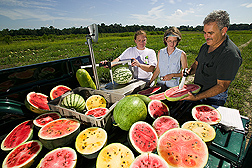| Read the
magazine
story to find out more. |
| 
In Charleston, S.C, geneticist Amnon Levi (right)
and technicians Laura Pence (left) and Mary Ballzigler (center) evaluate
watermelon selections derived from crosses between American heirloom cultivars
and wild watermelon accessions. Click the image for more information about
it.
|
Cutting-Edge Studies Focus on Broccoli, Peas and
Watermelon
By Luis Pons
December 5, 2005 Greener peas, wild watermelon, and
broccoli seed’s role in human health are among the hot topics these days
at the Agricultural Research Service's
U.S. Vegetable Laboratory (USVL)
in Charleston, S.C.
For almost 70 years, USVL scientists have found better ways to breed and use
many popular vegetables. That work continues in a state-of-the-art facility
opened in 2003.
It’s there that geneticist
Mark
Farnham is working with glucoraphanin, a cancer-inhibiting compound in
broccoli (Brassica oleracea). His previous work with
Johns Hopkins University in Baltimore, Md.,
has made it possible to classify the cancer-fighting potential of different
broccoli varieties.
Now, inspired by the discovery at Johns Hopkins that sprouted broccoli seed
has about 10 times more glucoraphanin than the plant itself, Farnham is
focusing on the vegetable's seed. This work may eventually lead to extracting
glucoraphanin from broccoli seed for pharmaceutical purposes-- something that
wouldn't be cost-effective using the whole plant.
USVL geneticist
Richard
Fery is working with genes that help make peas green in order to produce a
“double-green” southernpea (Vigna unguiculata).
Fery and colleagues have already used a gene called green cotyledon
to breed southernpea varieties widely used by the frozen-food industry. Now,
he’s developing varieties containing this gene and another one called
green testa.
Fery is working with South Carolina-based Western Seed Multiplication Inc.
to complete work that will lead to further development and release of the
double-green cultivars.
Meanwhile, geneticist
Amnon
Levi, plant pathologist
Judy
Thies and entomologist
Alvin
Simmons are trying to keep watermelon (Citrullus lanatus) varieties
safe from destructive fungi, insects and nematodes.
Among their interests is how wild relatives that resist diseases and pests
can help protect new domesticated watermelon cultivars. Breeders’
selection for desired fruit quality has given U.S. watermelon a narrow genetic
base, making it susceptible to diseases and pests.
Read
more about this research in the December 2005 issue of Agricultural
Research magazine.
ARS is the U.S. Department of
Agriculture's chief scientific research agency.